Isawajo Castle
-From castles of nation to forts of local power (1)-
Overview
Name: Isawajo Castle (Isawa-jo)
Alias:
Place: Mizusawa Oshu city, Iwate
Location: 39.17944758824907, 141.13601457813337
Type: Ancient Castle
Built: 802
Remaining remnants: Clay walls and dry moats
Title:
Type: Ancient Castle
Built: 802
Remaining remnants: Clay walls and dry moats
Title:
Brief History
Isawajo castle (胆沢城) is located over the river side terrace at the merging point of Kitakami-gawa river and its tributary Isawa-gawa river, in the north part of current Oshu city. Around castle site the angle of the grid of the land clearly different from surrounding area thus the scope of the remnant of the castle is clearly seen.
Isawa area is one of the largest alluvial fan of Japan between Isawa-gawa river and Koromogawa river, which consists of six layer terraces goes down from southward to northward. Because of shallow underwater layer formed by movement of Isawa-gawa river, in spite of the top of the plateau, water is acquired even at the middle of the terrace by wells.
Expansion of Imperial Household toward north
Being not affected by the flood of Kitakami-gawa river, the development of the north half of the alluvial fan had started from ancient era, that is certified by the existence of Tsunotsuka Kofun, a keyhole shaped tomb. Keyhole shaped tomb is common style of ancient Yamato dynasty and this tomb is at the northernmost, then there might be some connection between Isawa area and ancient Yamato dynasty then Isawa castle might be built based on this relationship.
In 7th century, the territory of Yamato Dynasty reached to the line of current Niigata prefecture, Fukushima prefecture and Miyagi prefecture, and outside this line there were local residents called as “Emishi”, which might have some relationship with the local residents of Hokkaido Island “Ainu”.
Yamato Dynasty tried to expand their territory by negotiation and suppression. On the captured land castles were built as military and administrative bases, and colonizers were attached for the defense of the castles. At first Nutari castle (Niigata prefecture) and Iwafune castle (Niigata prefecture) were built at current Niigata prefecture in the middle of 7th century, and Koriyama ruins (Miyagi prefecture) is thought as the castle of this period at Pacific Ocean side.
Rise of local residents
In 720, there arouse first large rise of local residents and the governor sent from central government was killed. The Imperial Household was forced to strengthen their administrative base at Tohoku region, then Tagajo castle (Miyagi prefecture) and Akita castle (Akita prefecture) which were built over a hill and has two layers of fences to strengthen defense ability at both side of Tohoku region.
In the latter half of 8th century, the Imperial Household turned to an aggressive expansion policy again, then crossed the border and entered into Kitakami basin. In response to this movement, local residents rose against Imperial Household army then central government and local residents entered into total war continued over 38 years.
In 774, Surugamaro Otomo (?-776) who was a regional commander of Imperial Household army ascended toward the border of current Miyagi prefecture and Iwate prefecture and stroke back the attack of local residents, along Azamaro Korehari (?-?), the leader of residents. But Azamaro revolted against next commander Hirozumi Ki (?-789) and killed in 780.
Struggle with Aterui and build of Isawajo castle
At this time Tagajo castle (Miyagi prefecture), a regional base of Imperial Household, was burnt down. In response to this situation, the Imperial Household sent troops but could not settle the situation. In 789 the Imperial Household sent large army lead by its general Kosami Ki (733-797), but the army intruded into Kitakami basin suffered fatal defeat at the battle of Subusi at the east side of Kitakami-gawa river.
It is said that resident army was commanded by its leader Aterui (?-802 who lived at current Maesawa area. It is recorded that resident army once faced the Imperial Household army then retreated, and Imperial Household army chased it and entered into narrow space between Kitakami-gawa river and hill then resident army shut the backward of Imperial Household army and encircled it.
In response to this, the Imperial Household sent the army to Tohoku region in 791 but there was no remarkable result. At this army Tamuramaro Sakanoue (758-811) served as one of deputy commanders. Later in 796 Tamuramaro Sakanoue was a general commander of the region and carefully prepared for next campaign for five years.
In 801, Tamuramaro Sakanoue marched to Tohoku region and might achieve certain result. Next year in 802 Tamuramaro visited Kitakami basin to build Isawajo castle under the order from Emperor Kanmu (737-806). The construction of Isawajo castle might have finished at that year then Tamuramaro was also appointed as the commander of Isawajo castle.
Structure of Isawajo castle
Isawajo castle is a square shaped one of 675 meter long outer barrier and 90 meter long square inner area. Outer barrier was a wall of about 4 meter tall and 2.4 meter wide formed by pressed clay, having a dry moat of 3 meter wide and 1 meter depth at outside. At the middle of south line, there was a main gate of the castle which was a spectacular one two layer barrack gate of 15 meter wide.
At the center of outer barrier, there was an inner area that had main hall of the castle. Main hall of the castle might be a red colored wooden palace of about 20 meter long and 15 meter wide, which might be used for ceremony and religions ritual. There are three barracks surrounding the main hall, which might be used for storage.
The south gate and main hall was connected by broad street of 20 meter wide and 200 meter long, which had two gates before main hall. The first gate was a large one of 12 meter wide, and ceremony for local residents might be performed in front of this gate. Due to limited excavation it is not clear if there are other three gate at each direction except south of outer barrier.
Surrounding inner area, administrative offices were built. At northward there was a function of supply and storage of goods transported from Kitakami-gawa river through small creeks, and at eastward there was an office of ceremony. At the side of south gate there were kitchens which kept foods and processed the dishes for ceremony.
The location and structure of Isawajo castle quite resembles to Roman castrum, in spite of being built by clay not by brick. If it is necessary to build a military base with minimum construction at distant unstable area, it might be a square shaped fort at the side of large river irrespective to the east and west of the globe.
End of expansion
In 802, during the construction of Isawajo castle, Aterui and other leader More (?-802) surrendered to Tamuramaro Sakanoue. As Isawa castle could separate Aterui from backward of Kitakami basin, Aterui was isolated and could not resist any more. Tamuramaro welcomed Aterui and More and took them to the capital Kyoto city.
Tamuramaro Sakanoue insisted to accept the surrender of Aterui and More and use them for stabilization, but the cabinet declined this plan and executed Aterui and More. The situation of south edge of Kitakami basin was fixed, then Tamuramaro next built Shiwajo castle (Iwate prefecture) at the inner area of Kitakami basin in 803.
Shiwajo castle was larger than Isawajo castle and might be planned for the center of Kitakami basin. But due to the damage by flood, in 811 Shiwajo castle was abolished and moved to smaller Tokutan castle (Iwate prefecture). At that year last campaign by Watamaro Funya (765-823) was performed at the north edge of Kitakami basin formerly served to Tamuramaro Sakanoue, and operation of the Imperial Household had finished.
Afterward of castle
The regional military headquarter named “Chinjufu” had moved from Tagajo castle to Isawajo castle closer to the front. But due to fiscal problem and political confusion, the Imperial Household could not place large army at Kitakami basin any more. Isawajo castle might be used about 150 years from construction but might be abolished in the middle of 10th century.
Now no building remains and remnants are covered by soil, but the shape of the castle gradually reveals by excavation. Combination of magnificent main gate and thick clay wall partially rebuilt shows the fierce confrontation between the great general of the Imperial Household and great leader of local residents in 1,200 years ago.
As there was too much gap between the gigantic size of the castle and a wilderness of Kitakami plain, the ruin of the castle was not used anymore and buried in the land. But hence the remnant of the castle has been well preserved in the land. It is hoped that the whole shape of Isawajo castle as a product of national enterprise emerges again with the history of the area.
Access
10 minutes drive from Tohoku Jidoshado Expressway Mizusawa interchange to parking of Oshu buried cultural properties museum at the next of castle site.































































No comments:
Post a Comment